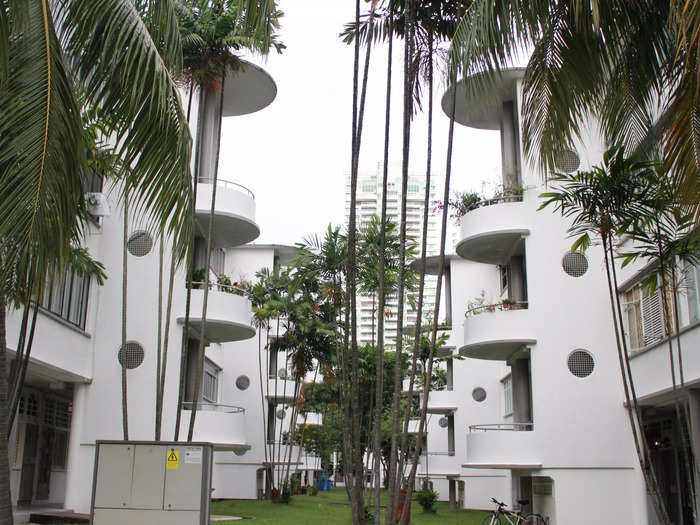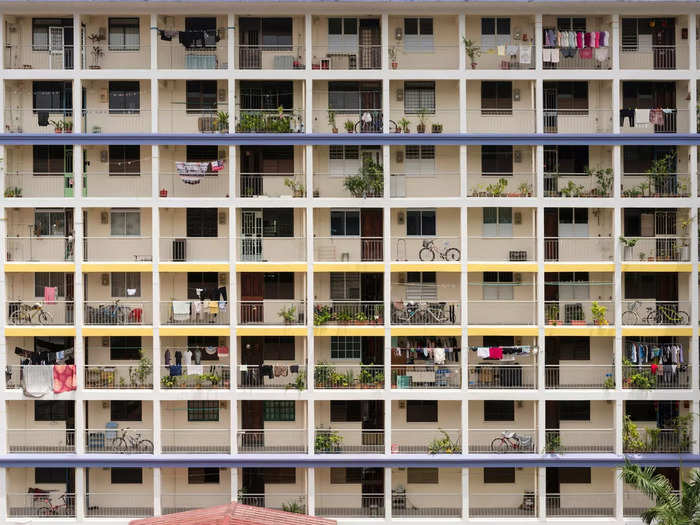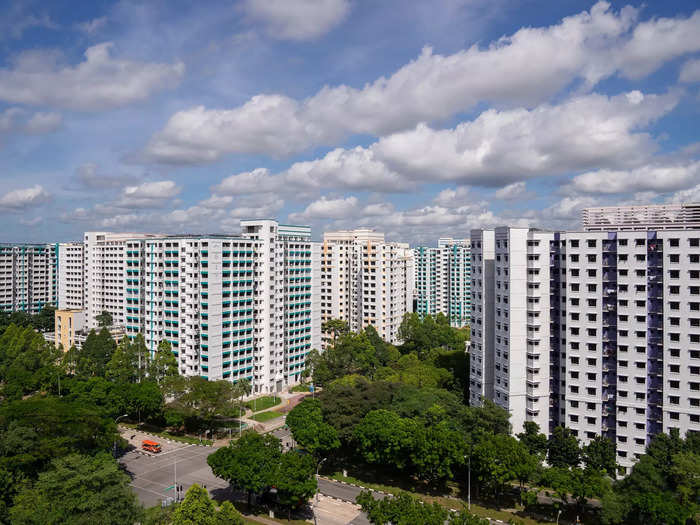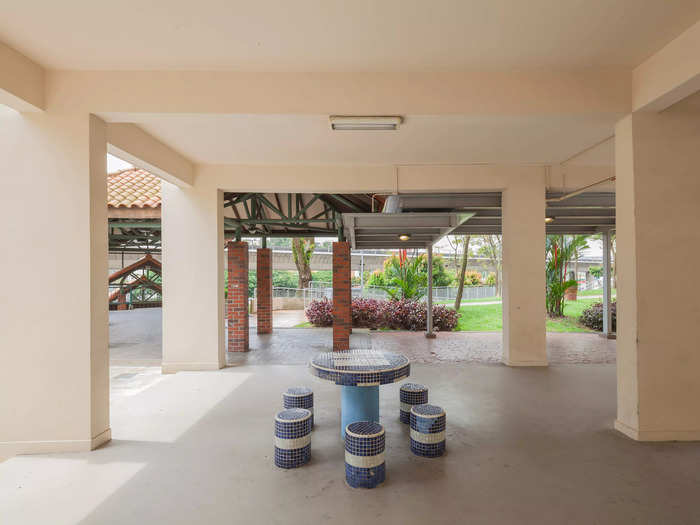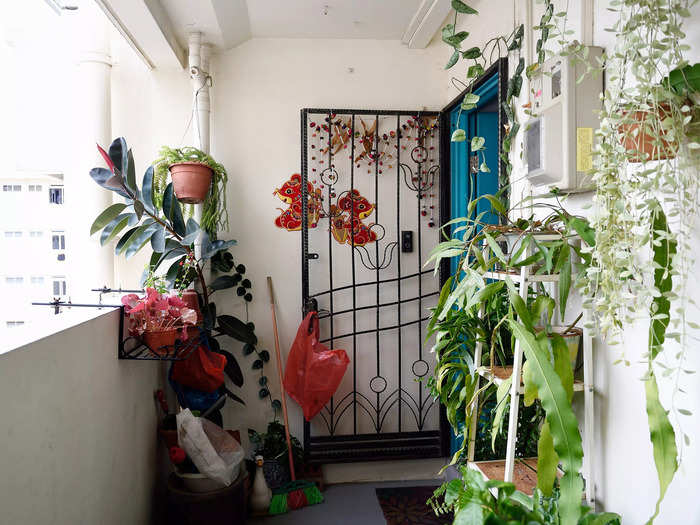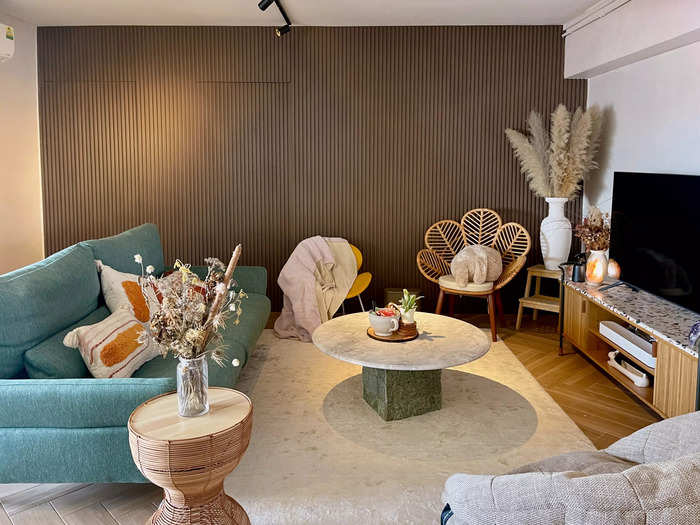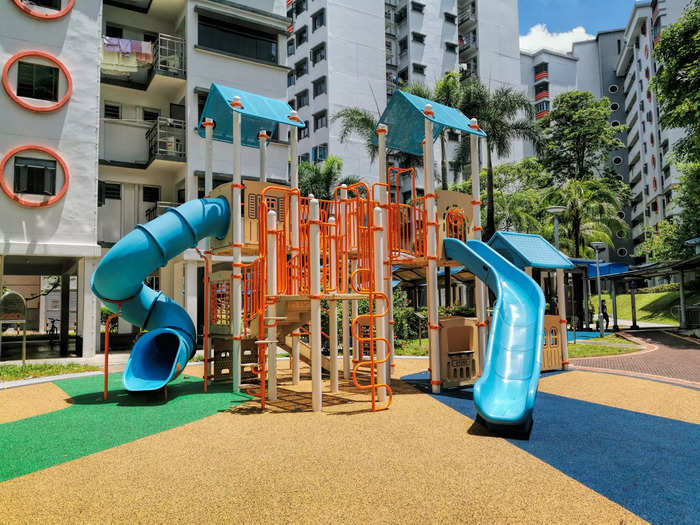Singapore's public housing apartments are also referred to as HDB flats.Kandl
- Singapore's public housing apartments are home to about 80% of the country's resident population.
- In recent years, some flats have gone on to fetch over 1 million Singapore dollars on the market.
Singapore's skyline would not be complete without its candy-colored, high-rise public housing apartment blocks.
Constructed by the Housing Development Board, these apartments are colloquially known as HDB flats.
Like many Singaporeans, I grew up in an HDB flat in central Singapore — and I've been living in the same one with my family for almost two decades.
It's an old housing complex by Singapore's standards, considering it was constructed in 1976. Most of my neighbors have lived here for as long as I have — and even longer. I know an elderly grandma downstairs who moved in just a few years after the block was built.
I went to elementary school five minutes from where I live, and my friends from back then — some of whom I still keep in touch with — all live nearby.
The older I get, the more I appreciate living in such a meticulously planned community — one of many in the country. Where else in the world can I find a hospital, a market, and a mall within a 15-minute walk — half of which has shelter from the rain?
Singapore and New York City are tied as the most expensive cities in the world to live in, but their public housing systems are worlds apart.
In the US, public housing is intended for low-income families, seniors, or people with disabilities.
In Singapore, however, it's a different situation: Public housing units are where about 80% of the country's resident population lives. It's considered one of the most successful public housing systems in the world.
And in Singapore, public housing does not mean inexpensive housing.
Despite being conceived as affordable housing for the masses, some HDB flats have sold for over $1 million on the resale market in recent years. In June, a 4-room flat was sold for $1.5 million Singapore dollars, or $1.1 million.
In 2021, there were 261 million-dollar HDB flats sold on the resale market, per the local paper The Straits Times.
The earliest public housing apartments were built in the 1930s — before Singapore gained independence.
Public housing apartments in Tiong Bahru, Singapore, that were built by the Singapore Improvement Trust after WW2. nortel1232010/Getty Images
These homes, known as SIT flats, were built by the Singapore Improvement Trust — HDB's predecessor — in Tiong Bahru.
Tiong Bahru is a trendy neighborhood in southern Singapore that's become known for its cafes and independent stores in recent years.
But before 1926, the area consisted mainly of mangrove swamps, cemeteries, and squatter settlements, per the National Library Board.
In response to the poor housing and sanitary situation in the area, the SIT was commissioned to improve the drainage system and build new homes for the squatters.
Some of these early public housing apartments still exist and are habitable.
In 2003, the Urban Redevelopment Authority placed 20 blocks of flats in the area under conservation status.
Over 1 million public housing flats have been built across Singapore since 1960.
The facade of an HDB flat at Kampong Kayu Road, Singapore. catchlights_sg
New HDB apartment blocks are still being constructed today.
Since they are considered leasehold properties, each new flat — known as a Build-to-Order, or BTO, apartment — is sold by the HDB on a 99-year lease.
As the name suggests, these homes are built upon order — meaning there's a median waiting period of about 3 ½ years before the houses are complete.
After getting married, most couples stay in their family homes or move in with their in-laws while waiting for their BTO apartments to be ready.
To apply for a BTO flat, applicants need to go through a ballot system. However, demand for these new flats is often higher than supply: Last year, there were 117,251 applications for 23,184 apartments.
Vanessa Tan and Shannon Teo, a millennial couple who turned their BTO into a modern Scandinavian-style home, told Business Insider that they balloted four times before success.
"We tried for two years," Teo said.
New HDBs come in different layouts to accommodate various household sizes and budgets.
HDB public housing apartment blocks in Jurong West, Singapore. Kokkai Ng/Getty Images
There are strict rules around who is eligible to apply for a BTO flat. Since it's public housing, it's meant for Singaporeans.
Different household types can apply for a BTO under varying conditions.
Broadly speaking, heterosexual Singaporean couples can apply for a BTO flat if they are either married or engaged. In this situation, at least one of the applicants must be a citizen, and the other must be a citizen or Singapore Permanent Resident.
Singles need to be at least 35 years old to apply. This includes anyone in a same-sex relationship, as same-sex marriage is not recognized in Singapore.
There are also different eligibility conditions for families or couples with non-residents.
Applicants will also have to meet an income ceiling if they want to apply for a BTO flat. The amount varies depending on the flat types that applicants are looking to buy.
HDB flats can be resold on the open market.
Singapore's HDB public housing void decks typically have tables and seats for neighbors to gather and interact. In this photo, the mosaic table top has a design of a Chinese chessboard on it that members of the public can use to play a game of Chinese chess. Tomatopictures/Getty Images
HDB flats on the open market are often referred to as resale flats.
Joy Oh, a Singaporean digital-content producer, told BI that she and her husband decided to look for a resale flat after failing to secure a BTO three times.
"We viewed 17 apartment units before we found our forever home," Oh said.
There are a variety of HDB flat sizes and layouts.
Front door of a Singapore HDB flat. Carlina Teteris/Getty Images
HDB flat types range from two-room apartments to executive flats that come with an additional study or balcony.
There are also community care apartments designed for seniors, with fittings such as anti-slip floors and handlebars in the bathroom.
For multi-generation families living under one roof, there is also a 3Gen flat layout that comes with four bedrooms and three bathrooms.
The wide range of HDB layouts means that homeowners can also choose the kind of houses they want depending on their lifestyle preferences.
Tobby Toh and Goh Kaiyi told BI that they downsized from a four-room flat to a three-room flat so they could better manage their finances.
"Clearing our housing debt was a step nearer to being financially free," Goh, a 35-year-old user-experience designer, said.
HDB flat buyers own the rights to their property for the duration of their lease.
The living room in the HDB of one of the couples who spoke to BI about their home. Amanda Goh/Insider
HDB flat owners have free rein over the interior design of their homes — as long as it does not compromise the building's structure.
Some homeowners have been getting creative with their houses.
Soh Jun Hao and Grace Lim, who live in a five-room HDB flat, told BI they wanted a "lived-in" look for their place.
In the two years since they moved in, they've filled the space with their favorite mementos.
"I didn't want it to look like a showroom," Lim said.
Other homeowners were inspired by their own way of life when it came to interior design.
Jasmine Wong and Rainier Ng, a couple living in the eastern region of Singapore, told BI they spent 5 months turning their HDB flat into a farmhouse-style home with wabi-sabi influences.
"I think it's just our way of living that inspired us," Wong said. "We've always liked nature and natural, raw-looking materials."
Each HDB estate typically consists of a few identical apartment blocks clustered together.
Colorful playground for children in an HDB estate in Singapore. slpu9945/Getty Images
Communal spaces such as void decks, playgrounds, fitness corners, and community gardens can be found on the estates.
These apartment blocks are often also served by the country's public transport system, with bus stops and train stations within walking distance.
Unlike Singapore's condos — which are private property — HDB blocks don't typically have dedicated tennis courts, indoor gyms, or swimming pools, although there are often such communal amenities nearby.
These HDB estates and neighborhoods make up the wider HDB towns, which are designed to be self-sufficient.
Singapore's public housing is designed to encourage social interaction and integration.
Two retirees play checkers at the void deck of a public housing block in Singapore. Roslan Rahman/AFP via Getty Images
In 1989, the government introduced the Ethnic Integration Policy to "ensure a balanced mix of ethnic groups in HDB estates," per the Singapore government's official website.
As a result, shared spaces in public housing — and the wider HDB estates — give people from all walks of life a chance to interact with one another.
And this, as journalist and researcher Dan Buettner says, is part of the reason why Singapore is the world's sixth Blue Zone — a region in the world where people live longer and healthier lives.
"Loneliness is largely a function of environment," Buettner told Fortune about Singapore's architecture. "If you live in a cul de sac in the suburbs, and especially if you don't like your neighbors, you're very unlikely to serendipitously run into someone and have a conversation."
But in Singapore, it's not just the open spaces on public housing estates where residents can spend time with each other. Hawker centers, open-aired food halls, are found near HDBs and offer another opportunity for residents to spend time with each other.
"You share tables and you're interacting with the stall user, interacting with the person next to you," Buettner told Fortune. "The chances you're going to run into an old friend or make a new friend are exponentially higher."

